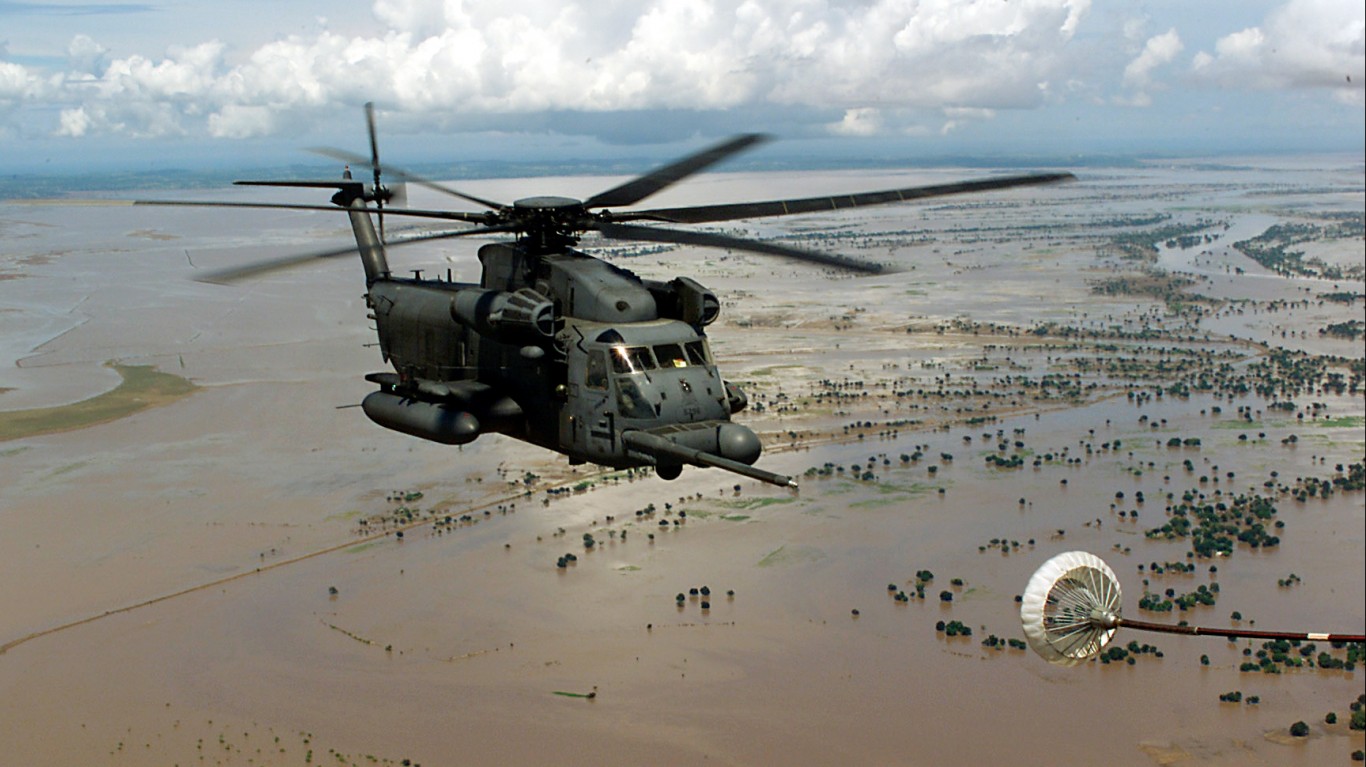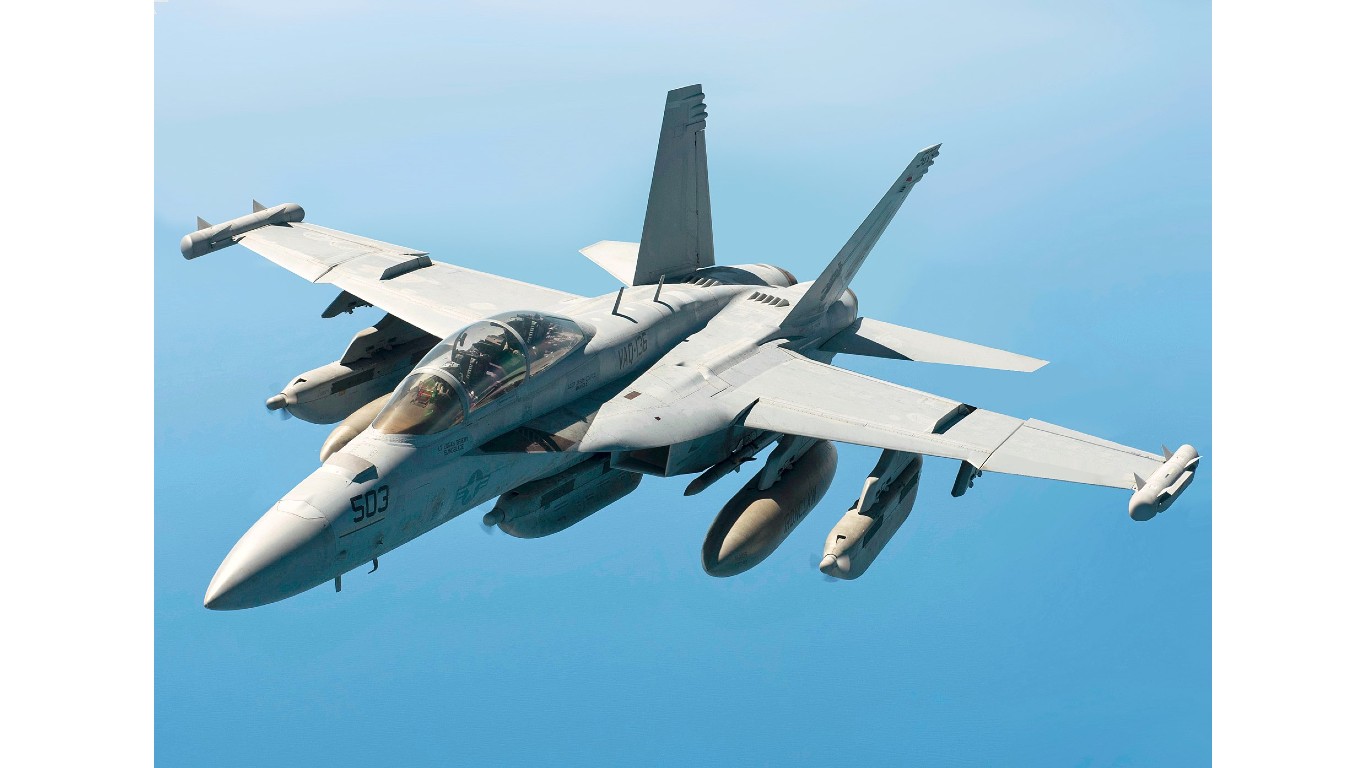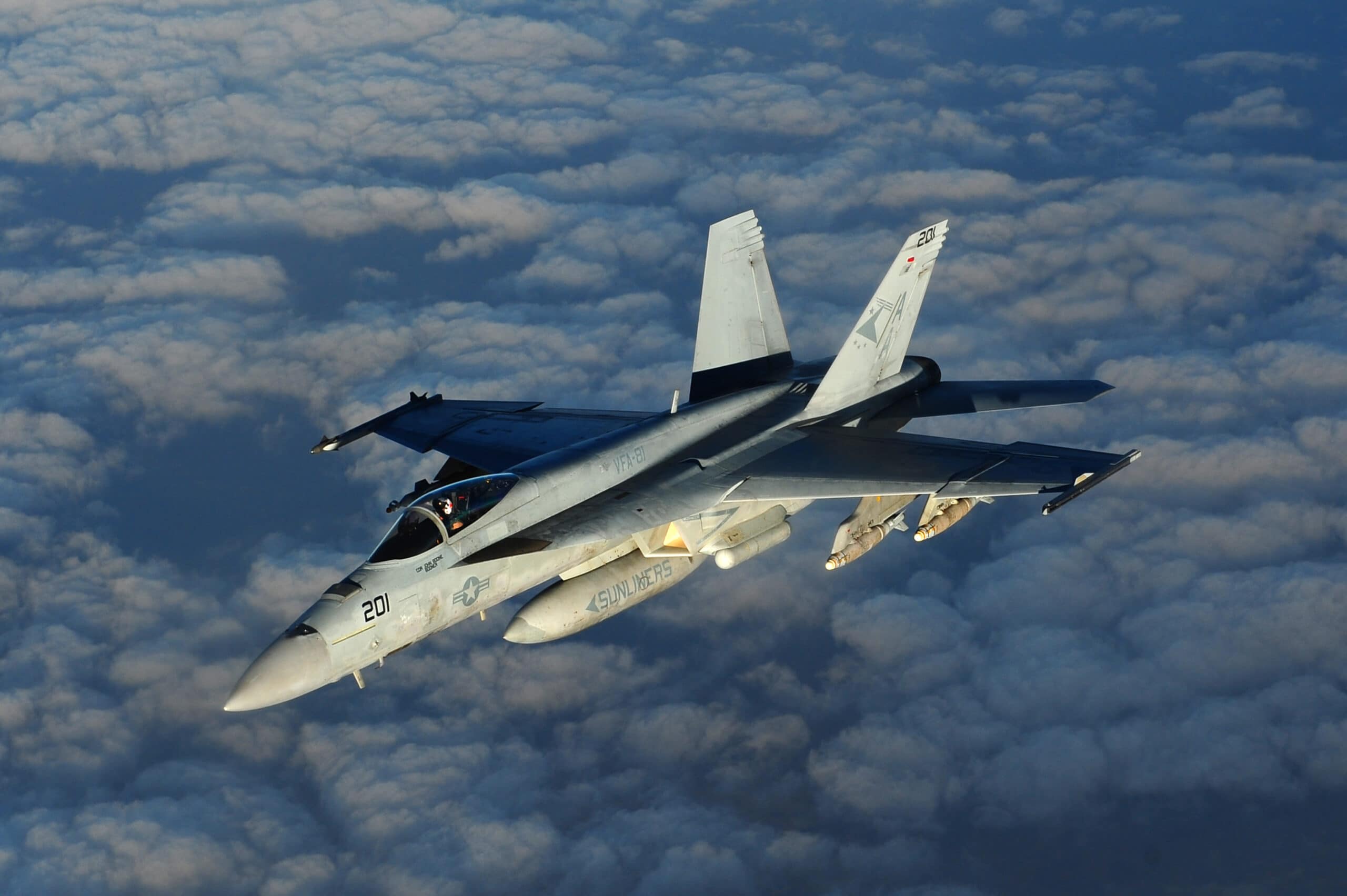
24/7 Wall St. Insights:
- The F/A-18E/F Super Hornet was introduced in 1999 and has become a staple combat aircraft of the U.S. Navy
- It can be equipped with air-to-air missiles, joint direct attack munitions (drop/guided bombs), or even anti-ship missiles; the 20mm M61 Vulcan cannon comes standard
- The Super Hornet proved effective in the Middle East in carrying out air strikes, throughout the U.S. Global War on Terrorism
- Also: Dividend legends to hold forever
The F/A-18E/F Super Hornet has made a name for itself as a powerhouse in the U.S. Navy since its introduction in 1999. Not to be confused with the earlier model, the original F/A-18 Hornet, the Super Hornet features a larger airframe, increased payload capacity, and advanced avionics. However, what truly sets the Super Hornet apart from the competition is its ability to carry a variety of missiles and ordnance, making it one of the most heavily armed aircraft in the Navy’s arsenal. (These are the most iconic combat aircraft built by Boeing.)
For some quick specs on the jet, it has a maximum takeoff weight of 66,000 pounds and can carry over 17,000 pounds of ordnance. The frame is outfitted to handle air-to-air missiles, joint direct attack munitions (drop/guided bombs), or even anti-ship missiles. Each of these jets also come standard with a 20mm M61 Vulcan cannon.
Outside of the E/F variants of the Super Hornet, another variation was developed, the EA-18G Growler, which specializes in electronic warfare. However, the Growler can still equip missiles and ordnance as well.
The Super Hornet is powered by two General Electric F414 engines and can hit speeds over Mach 1.5. It has a combat range of roughly 1,200 miles.
Since its introduction in 1999, the Super Hornet has been pivotal in a number of engagements and U.S. Navy operations. It proved effective in the Middle East in carrying out air strikes, throughout the U.S. Global War on Terrorism.
The Super Hornet stands above many fighter jets when it comes to its armament. However, it is just one of the fighter jets that is employed by the U.S. Navy. (This military stealth plane flies twice as fast as the speed of sound.)
24/7 Wall St. is taking a closer look at what other combat aircraft the Navy has in its arsenal. To identify the most heavily armed aircraft flown by the U.S. Navy, 24/7 Wall St. reviewed data from the 2024 World Air Forces report from FlightGlobal, an aviation and aerospace industry website, and ranked the aircraft according to their armament. Additionally, we’ve included supplemental information on the type of aircraft, how many are in active service, top speed and more. We have excluded all trainer aircraft.
Here is a look at the most heavily armed aircraft in the U.S. Navy:
Why Are We Covering This?

24/7 would like our readers to understand where their tax dollars are being spent. The Navy received $202.6 billion in government funding in 2024, second only to the Air Force at $216.1. billion. In fiscal year 2025, the Navy has requested $16.6 billion of its funding to purchase 75 aircraft and helicopters, which is actually slightly less than in 2024.
8. MV-22 Osprey

- Type: Tilt Rotor VTOL aircraft
- Year introduced: 2007
- Active aircraft: 27
- Top speed: 316 mph
- Armament: 7.62mm machine guns, 12.7mm machine guns
7. MH-53E Pave Low

- Type: Multirole transport helicopter
- Year introduced: 1981
- Active aircraft: 26
- Top speed: 196 mph
- Armament: 7.62mm M134 miniguns, 12.7mm Browning M2 heavy machine guns
6. P-8A Poseidon
- Type: Multi-mission reconnaissance, anti-submarine aircraft
- Year introduced: 2013
- Active aircraft: 118
- Top speed: 490 mph
- Armament: Torpedoes, naval mines, air-to-surface missiles, anti-ship missiles, stand-off cruise missiles
5. S-70 Black Hawk

- Type: Medium-lift multi-mission helicopter
- Year introduced: 1979
- Active aircraft: 454
- Top speed: 183 mph
- Armament: 7.62mm machine guns, Hellfire missiles, 12.7mm gatling guns, M134 gatling guns, rocket pods, 30mm chain gun
4. P-3 Orion

- Type: Multi-mission reconnaissance, anti-submarine aircraft
- Year introduced: 1962
- Active aircraft: 17
- Top speed: 466 mph
- Armament: Torpedoes, depth charges, Harpoon missiles, SLAM-ER missiles, Maverick missiles, naval mines, unguided rockets
3. EA-18G Growler

- Type: Carrier-based electronic warfare aircraft
- Year introduced: 2009
- Active aircraft: 153
- Top speed: 1,181 mph
- Armament: Detection pods, high band jamming pods, low band jamming pods, AN/ASQ-228 ATFLIR, SHARP, Harm missiles, AMRAAM missiles, Joint stand-off weapons
2. F-35C Lightning II
- Type: Multirole fifth generation strike fighter aircraft
- Year introduced: 2016
- Active aircraft: 30
- Top speed: 1,199 mph
- Armament: 25mm GAU-12/U cannon in external pod, Sidewinder missiles, Paveway guided bombs, Rockeye II bombs, Brimstone missiles, Storm Shadow missiles, drop bombs
1. F/A-18 Super Hornet

- Type: Carrier-based strike fighter aircraft
- Year introduced: 1999
- Active aircraft: 421
- Top speed: 1,187 mph
- Armament: 20mm M61A1 Vulcan automatic cannon, Sidewinder missiles, AMRAAM missiles, Harpoon missiles, HARM missiles, Maverick missiles, joint direct attack munitions, Rockeye II bombs, general purpose bombs
Essential Tips for Investing (Sponsored)
A financial advisor can help you understand the advantages and disadvantages of investment properties. Finding a qualified financial advisor doesn’t have to be hard. SmartAsset’s free tool matches you with up to three financial advisors who serve your area, and you can interview your advisor matches at no cost to decide which one is right for you. If you’re ready to find an advisor who can help you achieve your financial goals, get started now.
Investing in real estate can diversify your portfolio. But expanding your horizons may add additional costs. If you’re an investor looking to minimize expenses, consider checking out online brokerages. They often offer low investment fees, helping you maximize your profit.
Thank you for reading! Have some feedback for us?
Contact the 24/7 Wall St. editorial team.



